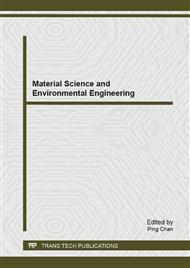[1]
S. Park, R.S. Ruoff, Nat. Nanotechnol. 4 (2009) 217-224.
Google Scholar
[2]
S. Stankovich, R.D. Piner, S.T. Nguyen, R.S. Ruoffm, Carbon. 44 (2006) 3342-3347.
Google Scholar
[3]
Z.J. Fan, W. Kai, J. Yan, T. Wei, etal., ACS. Nano. 5 (2011) 191-198.
Google Scholar
[4]
D.A. Dikin, S. Stankovich, E.J. Zimney, etal., Nature. 448 (2007) 457-460.
Google Scholar
[5]
S. Stankovich, D.A. Dikin, G.H.B. Dommett, K.M. Kohlhaas, E.J. Zimney, E.A. Stach, etal, Nature. 442 (2006) 282-286.
DOI: 10.1038/nature04969
Google Scholar
[6]
Y.W. Zhu, S. Murali, M.D. Stoller, A. Velamakanni, R.D. Piner, R.S. Ruoff, Carbon. 48 (2010) 2106-2122.
DOI: 10.1016/j.carbon.2010.02.001
Google Scholar
[7]
M.J. McAllister, J.L. Li, D.H. Adamson, H.C. Schniepp, A.A. Abdala, J. Liu, M. Herrera-Alonso, D.L. Milius, R. Car, R.K. Prud'homme, I.A. Aksay, Chem. Mater. 19 (2007) 4396-4404.
DOI: 10.1021/cm0630800
Google Scholar
[8]
X. Fan, W. Peng, Y. Li, X. Li, S. Wang, G. Zhang, F. Zhang, Adv. Mater. 20 (2008) 4490-4493.
Google Scholar
[9]
C. Wang, L. Zhan, W.M. Qiao, L.C. Ling, New. Carbon. Mat er. 26 (2011) 21-25.
Google Scholar
[10]
W. Lv, D.M. Tang, Y.B. He, C.H. You, Z.Q. Shi, X.C. Chen, C.M. Chen, P.X. Hou, C. Liu, Q.H. Yang, ACS. Nano. 3 (2009) 3730-3736.
Google Scholar
[11]
H.B. Zhang, J.W. Wang, Q. Yan, W.G. Zheng, C. Chen, Z.Z. Yu, J. Mater. Chem. 21 (2011) 5392-5397.
Google Scholar
[12]
S. Stankovich, D. Dikin, G. Dommett, K. Kohlhaas, E. Zimney,E. Stach, R. Piner, S. Nguyen, R. Ruoff, Nature, 2006, 442, 282.
DOI: 10.1038/nature04969
Google Scholar
[13]
T.N. Zhou, F. Chen, K. Liu, H. Deng, Q. Zhang, J.W. Feng, Q. Fu, Nanotechnology. 22 (2011) 045704.
Google Scholar
[14]
C. Nethravathi, M. Rajamathi, Carbon. 46 (2008) 1994-(1998).
Google Scholar
[15]
H.M. A Hassan, V. Abdelsayed, A.E.R.S. Khder, etal, J. Mater. Chem. 19 (2009) 3832-3837.
Google Scholar
[16]
S. Stankovich, D.A. Dikin, R.D. Piner, K.A. Kohlhaas, A. Kleinhammes, Y. Jia, Y. Wu, S.T. Nguyen, R.S. Ruoff, Carbon. 45 (2007) 1558-1565.
DOI: 10.1016/j.carbon.2007.02.034
Google Scholar
[17]
B. Tryba, A.W. Morawski, M. Inagaki, Carbon. 43 (2005) 2397-2429.
Google Scholar
[18]
E.H.L. Falcao, R.G. Blair, J.J. Mack, L.M. Viculis, C.W. Kwon, M. Bendikov, R.B. Kaner, B.S. Dunn, F. Wudl, Carbon. 45 (2007) 1364-1369.
DOI: 10.1016/j.carbon.2007.01.018
Google Scholar



